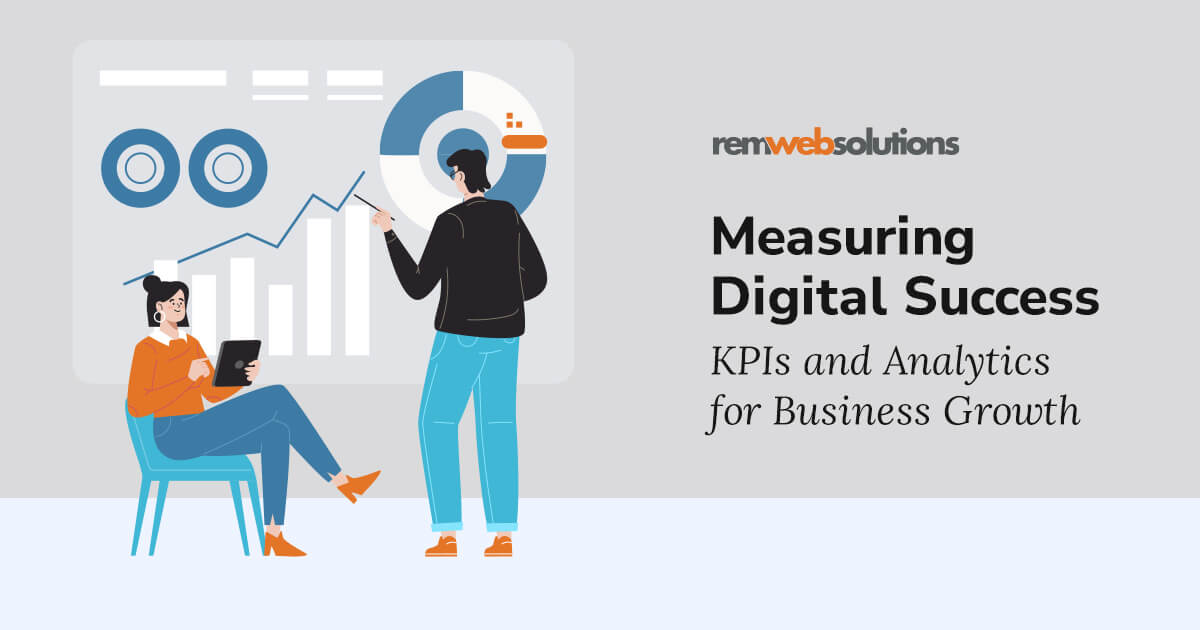
Digital marketing moves fast. Campaigns launch, data rolls in, and before you know it, the whole process starts over.
But in today's data-driven business landscape, it pays dividends to pause and adequately evaluate your digital marketing efforts. After all, how will you know what's working if you don't accurately measure performance?
By regularly tracking key metrics and analytics for your website, social platforms, and beyond, you tap into an invaluable resource: actionable insights. These nuggets of digital gold can inform strategy changes that catapult your brand to the next level.
Read on to discover why measurement matters, which digital marketing KPIs you should track, which tools to use, and how converting data into growth strategies sustains success.
At REM Web Solutions Inc., we thrive on helping our customers grow their businesses in tangible and impactful ways. If you need support with your digital marketing efforts or website design and development, don’t hesitate to reach out. Our skilled team is always here to support you in navigating the digital landscape!
Defining Digital Marketing Success
Let's start with the basics.
Key performance indicators (KPIs) are specific quantifiable measures used to gauge performance. For digital marketing, vanity metrics like clicks and views don't cut it. The impact on leads and revenue generation is what actually matters.
Dozens of potential KPIs exist across channels. Savvy marketers focus on trends for metrics that signal marketing success is leading to sales and revenue.
Common examples include:
Website conversion rate
Cost per lead
Customer lifetime value
In other words, dial down the microscope on metrics that ladder up to impact and scalability.
The Benefits of Tracking KPIs
Monitoring critical digital marketing metrics over time unlocks game-changing benefits:
Identify Optimization Opportunities
Accurately tracking website visitors, engagement rates, conversion funnel drop-off points, and more allows you to spot areas for improvement. If your bounce rate spikes, you can pinpoint confusing pages to update. Or, if conversion rates dip on a particular campaign, you can tweak your targeting.
Measurement enables the refinement of both strategy and execution. With a constant pulse on performance, you can nip issues in the bud before they become catastrophic. Optimization is a continuous process - and proper measurement makes it possible.
Benchmark Against Competitors or Past Performance
You can evaluate campaign or asset performance against previous results or competitor activity with historical data and industry benchmarking. Are you gaining or losing ground? Getting a 20% increase in traffic is great unless your competitor just increased by 40%.
Context is everything. Look at key metrics like market share, page views, lead generation, and sales numbers. If competition advances faster, it signals urgency to analyze why and rectify the situation.
Inform Budget and Resource Allocation Decisions
By quantifying marketing ROI across channels, you can double down on what delivers, cut what doesn't, and optimize spending. Measurement guides strategy ‒ let the numbers lead budget decisions rather than guesswork.
Have a campaign with a steadily declining conversion rate? Shift some of its budget to better-performing initiatives. Which content pieces or campaigns drove the most qualified leads this month? Invest more in those.
Proper analytics-based decision-making enables optimal efficiency.
Keep the Entire Organization Accountable
Accurately tracking KPIs clarifies what matters, focusing teams and aligning people to objectives. Results make performance transparent ‒ both good and bad. This accountability fuels improvement.
What's measured is what gets done. If leadership emphasizes monthly recurring revenue growth, then teams organize around driving subscriptions. Public goals paired with regular performance updates ensure alignment.
Be Ready for Potential Investors
Investors want proof of demand for your product and a path to profitability. Solid growth metrics make you investor-ready. Let's say you are showing consistent 10% month-over-month increases in sales. That proves remarkable scaling potential. Data demonstrating market traction makes fundraising easier.
Key Performance Indicators to Track
Many universal digital marketing metrics spanning engagement, sales, and ROI warrant tracking. It's also wise to customize metrics related to overarching business objectives.
Here are some recommended highlights:
Quantitative Engagement Metrics
Raw traffic and interaction metrics quantify initial brand exposure and content resonance. While vanity metrics like social media followers should not drive strategy alone, strong engagement signals marketplace interest.
These metrics measure how site visitors and social followers interact with brand touchpoints:
Site visitors
Pages per visit
Average time on page
Bounce rates
Email open rates
Social followers
Content shares/reactions
Monitoring engagement shows whether you're capturing interest. Changes prompt deeper investigation ‒ are poor content or user experience turning them off? Falling engagement indicates fading interest from your audience.
Lead & Sales Conversion Rates
Beyond generalized attention, conversion rate KPIs reveal tangible marketing ROI. The most insightful metrics track users moving from consideration to purchase.
Monitor conversion rates at each funnel stage:
Email list sign-ups
Free trial sign-ups
Contact or demo requests
Online checkout conversion rate
Sales won from leads
Tracking conversion funnel fallout highlights areas to improve. Getting more sign-ups means little if you don't convert them down the line.
Optimizing the conversion rate at each funnel stage is crucial. More prospects entering the top doesn't help much if most drop out due to friction. The solution is to fix leaks in the pipeline.
Return on Investment Tracking
Marketing spending should be directly tied to tangible business results by channel.
Typical ROI evaluations include:
Cost per lead
Cost per customer acquired
Marketing expense vs. sales revenue
Customer lifetime value (LTV)
High ROI programs should get more budget. Low performers should get cut or fixed. Marketing ROI metrics verify your growth drivers. Revenue attribution clarifies precisely how many sales each channel or campaign contributes. Customer LTV shows true profitability over time.
Utilizing Analytic Platforms
So, with that in mind, how can you actually track and monitor these metrics? The answer lies in utilizing analytic platforms. These programs allow for the collection, analysis, and reporting of data from various sources such as social media, websites, and email campaigns.
The following tools provide the robust analytics needed to monitor essential digital marketing KPIs:
Google Analytics
Google Analytics offers deep intelligence into the customer journey. See where visitors come from, how they navigate your site, conversion rates page-by-page, and more. These behavior flow insights unlock refinement.
It is the gold standard for understanding website traffic and behavior flow via:
Traffic source analysis
Location demographics
Page optimization ratings
Conversion tracking
Social Media Insights
All major platforms have built-in analytics on social media advertising and organic post performance.
You can view:
Impressions and reach
Engagements and clicks
Follower growth
Traffic referral data
See what content resonates to guide your strategy. Test different creative approaches, analyze performance data, and double down on what pulls best. Social media analytics is vital for maximizing reach and engagement.
Email Marketing Metrics
Leading email service providers track opens, click-throughs, subscriber engagement levels, and more to inform messaging and list management decisions.
See how subject lines impact open rates, which types of content get the most clicks, and how subscribers flow from one segment to another. Use this info to craft better campaigns.
The Role of Surveys and Polls
Also, consider quick feedback options like embedded polls or post-purchase surveys to ask customer opinion questions like "How easy was the checkout experience?"
These form-based tools provide valuable information to help improve customer satisfaction and loyalty. The Net Promoter Score, for instance, shows the percentage of customers likely to promote your brand to friends. It can be seen as a KPI for customer experience.
Pro tip: Limit surveys to 1-3 quick questions and offer an incentive for participation.
Converting Data into Growth Strategies
Armed with accurate analytics, it is now time to develop strategies to move the needle. Measurement without action is pointless.
To use these valuable insights to drive growth, you must:
Set SMART Goals
First, set Specific, Measurable, Achievable, Relevant, Time-Bound (SMART) key performance indicator (KPI) targets for the next quarter.
For example:
Increase website conversion rate by 2% before next quarter
Boost social media engagement by 15% after an influencer campaign
Generate 300 new email list sign-ups with a yearly lead magnet
Quantifiable objectives set the direction you need to take and motivate the team to achieve big things.
Identify Top Performing Assets
Analyze historical data to reveal your best-performing marketing assets across channels. Identify campaigns, ad sets, and content pieces with the highest returns.
Then, shift the budget to amplify and build upon these winners. More funding should follow what already works.
Phase Out Poor Performers
Conversely, cut ineffective initiatives, dragging down performance. Eliminate paid campaigns or content series with low ROI. Repurpose those marketing dollars into proven success areas.
Ruthless efficiency maximizes results.
Forecast Realistically
Model next-period projections based on historical trends and seasonality. Set specific forecasts for lead volume increases, revenue growth, email list expansion, and more. For example, let's say your website typically receives a spike in traffic during the holiday season. Use this data to project an increase in conversions and revenue during this time.
Basing forecasts on data provides credible targets to rally the team around.
Prioritize Optimization Opportunities
Address identified weak points impacting KPIs, like leakage within the conversion funnel. Improve on-page elements hurting engagement. Refine targeting and messaging per insights.
Fix what's broken to lift performance.
Develop Campaigns Matching Revealed Interests
Next, analyze consumption patterns and engagement data to build future initiatives addressing explicitly demonstrated customer needs and interests. Serving messaging and offers that match your target audience's demand and preferences can boost campaign success rates.
Continuously Analyze and Adapt Strategy
Measurement and refinement is an ongoing process. Continually analyze the latest period KPI reporting, compare to goals, adapt strategy based on new learnings, and set the next period's targets.
Rinse and repeat to drive perpetual improvement.
The numbers will speak. Will you listen? Analytics paint the path forward. They show what's working and reveal hidden flaws to address. But you need to take action on those insights.
Final Thoughts
Implementing a clear digital marketing measurement strategy paves the path for data-driven decisions, impactful optimization, and, ultimately, business growth. Vanity metrics must take a backseat to KPIs correlated to revenue and profit generation - it's the only way to understand actual effectiveness.
While it takes some effort to track, digital analytics tools have made gathering actionable performance data more accessible than ever. You have the power to identify what works and what doesn't.
Wield these insights wisely, and your digital marketing will reach the next level. Here's to leveraging analytics for explosive growth!
At REM Web Solutions Inc., we thrive on helping our customers grow their businesses in tangible and impactful ways. If you need support with your digital marketing efforts or website design and development, don’t hesitate to reach out. Our skilled team is always here to support you in navigating the digital landscape!























